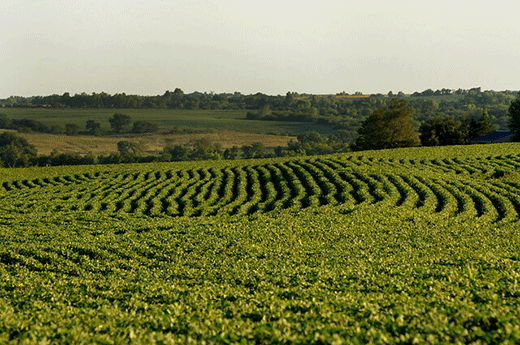Parsons, Kansas, USA
April 5, 2019
 A Kansas State University study has shown that planting a mustard seed cover crop ahead of soybeans can help reduce the incidence of charcoal rot in those fields, ultimately improving soybean yields.
A Kansas State University study has shown that planting a mustard seed cover crop ahead of soybeans can help reduce the incidence of charcoal rot in those fields, ultimately improving soybean yields.
Kansas State University researchers have received national recognition for a study showing that planting a mustard cover crop helps to improve soil health and, ultimately, boosts soybean yields.
Their work, funded by the Kansas Soybean Commission, has been recognized by the Supporters of Agricultural Research, a non-partisan coalition that helps to increase federal investment in agriculture.
SoAR featured the K-State study in the report, Retaking the Field: Science Breakthroughs for Thriving Farms and a Healthier Nation, published March 27 and highlighting several pioneering research projects in the United States.
“Our research team looked at how we can manage soil health to improve its productive capacity,” said Gretchen Sassenrath, a research agronomist at the Southeast Research-Extension Center in Parsons.
Farmers in southeast Kansas know all too well that the soil in their region contains an abnormally high amount of charcoal rot, a fungus that chokes the plant’s recycling system so that it cannot get nutrients or water, ultimately killing its roots.
“Charcoal rot tends to be worse in hot, dry conditions, and that’s what happens in Kansas in the summer,” Sassenrath said. “We get hot and dry and the charcoal rot grows and infects our soybean plants.”
There are chemical treatments for charcoal rot, but Sassenrath and colleagues Chris Little, Xiaomao Lin and Kraig Roozeboom were interested in finding natural agents to counter the effects of the fungus.
It led them to a mustard seed cover crop, the same plant that is used to make the condiment that many like to squirt on a hot dog.
The plant, Sassenrath said, “has a high glucosinolite concentration. Glucosinolate is the ‘tang’ that we like in mustard, but in soil, the glucosinolate produced in the mustard plant acts as a bio-control of the charcoal rot fungus.”
Sassenrath added that the species used in this study is different from a weedy mustard cover crop that is better off sprayed and killed with a herbicide.
Over two growing seasons, the K-State researchers showed that planting mustard seed as a cover crop reduces the incidence of charcoal rot in the soil.
“Mustard seed has actually been shown in other systems to improve the overall soil health,” Sassenrath said. “The approach I am taking is more of a holistic approach. For example, if a person is healthy, they might come into contact with people with a cold, but they won’t get sick themselves because they are overall healthy.
“In the same way, if we can support the soil in a positive way with positive microbes and things that they need, it improves the overall soil health and the soil will be better able to manage diseases that are naturally there all the time.”
The researchers also tested various management options, including planting soybeans into standing mustard seed; mowing it; or tilling it to incorporate residue into the field.
Their key finding: leave the mustard crop as intact as possible.
“If we just rolled the mustard cover crop over the top of the soil and planted straight into that, that was the best in terms of reducing the charcoal rot,” Sassenrath said.
The group is continuing its work, including looking at effects on yields due to sudden death syndrome and soybean nematodes. “It’s been suggested that the mustard can control those or have some impact on preserving yield when those are present,” Sassenrath said. “But we don’t know for sure.
“Again, it’s a holistic approach to soil health and getting more bushels per acre. There is a lot of promise with this mustard seed as being a mechanism or a tool that can be used to improve the overall soil health.”